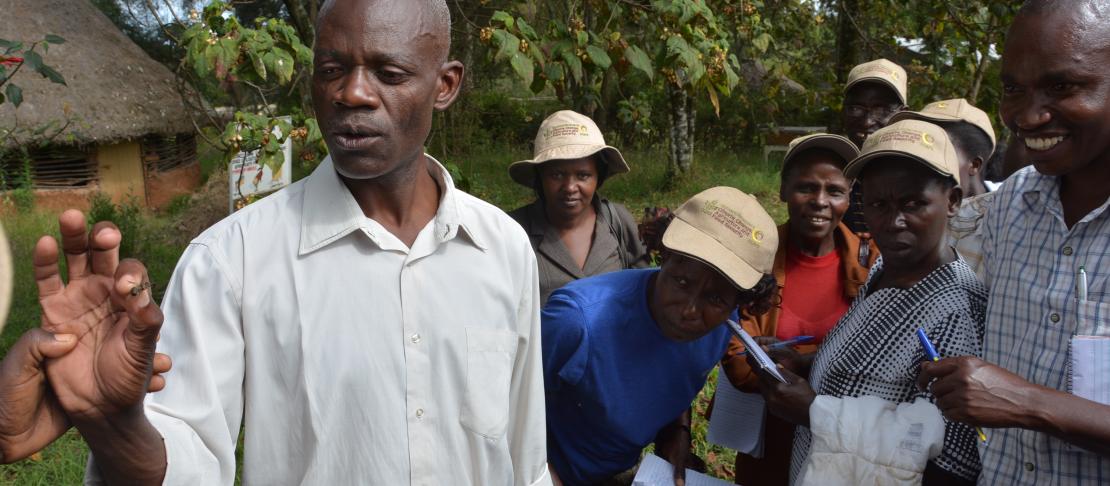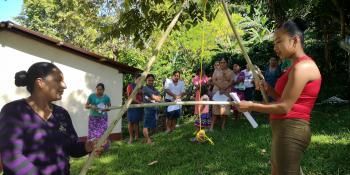Nyando farmers on a journey to spur adaptation to climate change

Future scenario planning will help smallholder farmers improve their adaptive capacity and reduce shocks caused by climate variability.
Farmers from the Nyando climate-smart villages (CSVs) along with seven representatives from government and non-governmental organizations were involved in a six day climate adaptation learning journey in November 2014 to enable them prepare for their future climate. Analogue maps for Nyando were developed using the climate analogue tool by the CGIAR Research Program on Climate Change, Agriculture and Food Security (CCAFS). Through a consultative forum between farmers, CCAFS scientists and partners, six analogue sites were identified thereby creating an opportunity for farmers and partners in Nyando CSVs to envisage how their climate and associated agricultural systems will look like in the future. Additionally, they would learn how adaptive technological innovations and practices will improve farming systems and fit into their local adaptation plans.
Learn how to use the climate analogues tool
When we work with farmers on the ground, sometimes, they do not take the information seriously. Therefore exposing farmers to other areas that are already experiencing their future climate is a novel and bold approach to learning about climate change and start preparing for it. Indeed, Nyando CSV farmers interacting with other farmers make them appreciates new technologies that are out there,”
said Wilson Aore from the Kenya Agricultural & Livestock Research Organization (KALRO).
The analogue sites identified for Nyando CSV were mainly around the Lake Victoria basin, including the semi-arid regions in Kuria and Marigat in Migori and Baringo Counties respectively. The climate adaptation learning journey brought together 16 farmers who traversed different agro-climatic zones covering 12 counties in Kenya. Hellen Were, a woman farmer Kisumu County said:
I embarked on a climate adaptation learning journey ready to learn, as a mother, we have been grappling with unpredictable rainfall every year. Therefore, to be able to visit other areas in Kenya that are already experiencing our future climate, I will be able to start planning for the future, instead of waiting for the future to shape us."
Have a look at the photos below:
Farmers were happy to be Nyando representatives in the learning journey. Indeed, having lived on their farms all their lives, except for the few who had worked in some urban centres, one of the critical obstacles to developing meaningful adaptation and mitigation practices and technologies is the difficulty of comprehending in real terms what the future climate of a particular area will look like, and how farmers may react to the future climate. Another woman farmer from Kericho County, Agnes Rotich said:
Turbulent times lie ahead for our children in the upper watershed in Nyando CSV. Part of our problem is that we not fully understanding the extent of the drought and intense heat because we live in the highlands. The communities downstream of us face floods and droughts almost every year. In addition, we are not prioritizing strategies that can help us and them cope with extreme weather events.”
CSA practices and technologies that the farmers and CCAFS partners learned included:
- Soil moisture conservation strategies that included engineering solutions like irrigation schemes, bench terracing reinforced with stone gabions to hold water and allow it to seep into the ground, and planting and protecting of fruit trees across the landscape
- Soil fertility improvement such as organic farming, fertilization and pesticide use
- Growing of drought resistant crops that can be harvested three times a year such as sweet potato and cassava
- Dairy cow and dairy goat feed management practices including protein supplementation for increased milk production
- Agricultural crop value addition processes and collective marketing for groundnuts, honey, fruits, sorghum and milk
- Poultry production and collective marketing
- Postharvest loss reduction for animal feeds by storing in plastic silos, use of muskan milk containers that are airtight during transportation to maintain excellent milk quality as well and cereal banking using airtight metal containers
- Establishment and management of fruits orchards e.g. mango, citrus and watermelon
Michael Ogara, a farmer from Kamuana Village said:
I have learned a lot during these 6 days of learning. I learned how to prepare mango tree nursery, how to graft mango stocks that are drought and disease resistant with good quality and high yielding scions. I also learned that mango trees need fertilization at least every three months to increase increased fruit production. I intend to start with 20 grafted mango seedlings on my farm and train about 30 other farmers.”
Adaptation demands for team work
Adapting to climate change starts with all of us, including farmers, national governments, development agencies and scientists. In Nyando CSV and the rest of East Africa, it is impossible for farmers to avoid floods and droughts. However, it is not impossible to be prepared for the changing climate. All the capable stakeholders must organize themselves starting now in order to be ready in the future. The key is to mobilize resources (including climate-smart knowledge and skills) and work together as a team with one objective: to be a step ahead of the changing climate.
Learn more about the analogue tool
Mary Nyasimi, Philip Kimeli and Solomon Kilungu all work for CCAFS East Africa



